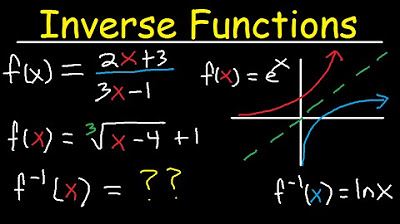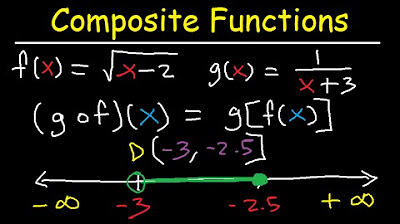Introduction to Inverse Functions
TLDRThis video script explains the concept of inverse functions in a clear and engaging manner. It outlines the process of finding the inverse function by replacing f(x) with y, switching x and y, and solving for y. The script provides examples, including finding the inverse of functions like 3x + 9, x^2 - 4, and cube root of (3x + 8). It also discusses how to determine if two functions are inverses by composing them and checking if they result in x. Additionally, the script explains the graphical relationship between a function and its inverse, highlighting their symmetry about the line y=x, and uses the horizontal line test to demonstrate when an inverse function is a valid function.
Takeaways
- 🔢 To find the inverse function, replace f(x) with y and then switch x and y in the equation.
- 🔄 The concept of inverse functions is based on the idea that the graph of the inverse is a reflection over the line y=x.
- 📐 For the function f(x) = 3x + 9, the inverse function is f^(-1)(x) = (x - 9) / 3.
- 🌐 If a function has an inverse, it should pass the horizontal line test, indicating it is a one-to-one function.
- 🛑 Functions that fail the horizontal line test (not one-to-one) will not have valid inverse functions.
- 💡 To illustrate the inverse relationship, consider a point (a, b) under the function f(x), its inverse point will be (b, a).
- 📌 For the function f(x) = x^2 - 4, the inverse function is the square root of (x + 4), or ±√(x + 4).
- 🌠 To verify if two functions are inverses, compute the composite functions f(g(x)) and g(f(x)) and check if both equal x.
- 🔍 The graph of y = x^2 and its inverse y = ±√x demonstrate symmetry about the line y = x.
- 🚫 If the original function's graph touches a horizontal line more than once, its inverse will not be a function as it fails the vertical line test.
Q & A
What is the inverse function of f(x) = 3x + 9?
-The inverse function can be found by replacing f(x) with y, switching x and y, and then solving for y. For f(x) = 3x + 9, the inverse is y = (x - 9) / 3 or y = x/3 - 3.
How do you determine if two functions are inverses of each other?
-To determine if two functions are inverses, you need to compose the functions, f(g(x)) and g(f(x)), and show that both result in the identity function, x. If both compositions simplify to x, then the functions are inverses.
What is the inverse function of f(x) = x^2 - 4?
-The inverse function is found by taking the square root of both sides after switching x and y and adding 4 to both sides. So, the inverse function is y = ±√(x + 4).
How can you check if a function passes the horizontal line test?
-A function passes the horizontal line test if every y-value on its graph corresponds to exactly one x-value. This means the graph of the function touches any horizontal line at most once.
What property do inverse functions have regarding their symmetry?
-Inverse functions are symmetric about the line y = x. This means that if you reflect the graph of a function across the line y = x, you will get the graph of its inverse function.
What happens if a function does not pass the horizontal line test?
-If a function does not pass the horizontal line test, it means that it is not a one-to-one function. As a result, its inverse will not pass the vertical line test and is not a function.
How do you find the inverse function of f(x) = ∛(3x + 8)?
-To find the inverse, replace f(x) with y, switch x and y, and solve for y. This results in y = ∛(3y + 8). After simplifying, you get the inverse function as y = (x^3 - 8) / 3.
What is the significance of a function passing the vertical line test?
-Passing the vertical line test indicates that a function is well-defined and unique; each x-value corresponds to exactly one y-value. This is a requirement for a function to have an inverse that is also a function.
How can you use the graph of a function to determine if its inverse is a function?
-If the original function's graph passes the horizontal line test (touches any horizontal line at most once), then its inverse will pass the vertical line test and be a function. The graph of the inverse function will be the reflection of the original graph across the line y = x.
What is the relationship between the horizontal and vertical line tests for a function and its inverse?
-If a function passes the horizontal line test (is one-to-one), its inverse will pass the vertical line test and be a function. Conversely, if a function does not pass the horizontal line test (is not one-to-one), its inverse will not pass the vertical line test and will not be a function.
How do you determine the domain and range of the inverse function?
-The domain of the inverse function is the range of the original function, and the range of the inverse function is the domain of the original function. This is because the roles of x and y are switched when finding the inverse.
Outlines
📚 Understanding Inverse Functions
This paragraph introduces the concept of inverse functions, explaining how to find the inverse of a given function. It starts with a simple example of a linear function, f(x) = 3x + 9, and walks through the steps of replacing f(x) with y, switching x and y, and solving for y to obtain the inverse function, which is x - 9 / 3. The explanation extends to quadratic and cubic functions, emphasizing the process of switching variables and solving for the isolated variable. The paragraph also discusses the concept of points being inverses of each other and concludes with the method to determine if two functions are inverses by composition, showing that both f(g(x)) and g(f(x)) should equal x.
📈 Graphing Inverse Functions
This paragraph delves into the graphical representation of inverse functions, using the function f(x) = x^2 as an example. It explains the process of finding the inverse function graphically by switching x and y and isolating the variable. The paragraph highlights the symmetry of inverse functions about the line y=x, which is a key property indicating that they are reflections of each other. It also introduces the concept of the vertical line test for functions and the horizontal line test for inverses, explaining how these tests can be used to determine if a function and its inverse are valid pairs. The explanation is supported with a visual representation of the functions and their inverses on a graph.
🔄 One-to-One Functions and Their Inverses
This paragraph discusses the importance of one-to-one functions when considering inverses. It explains that if the original function is one-to-one (passes the horizontal line test), its inverse will also be a function (passes the vertical line test). The example of y = x^2 is used to illustrate this concept, showing that the right side of the function is one-to-one and its inverse, y = √x, is a valid function. The paragraph further clarifies that if the original function is not one-to-one (does not pass the horizontal line test), its inverse will not be a function (fails the vertical line test). This is demonstrated by showing the entire graph of y = x^2 and explaining why its inverse is not a function over its entire domain.
Mindmap
Keywords
💡Inverse Function
💡Switch x and y
💡Solve for y
💡Composite Functions
💡Symmetry
💡Vertical Line Test
💡Horizontal Line Test
💡Cube Root
💡Square Root
💡Algebraic Manipulation
💡Graphing Functions
Highlights
Explaining the concept of inverse functions in a clear and structured manner.
Describing the process of finding the inverse function by replacing f(x) with y and switching x and y.
Using the example of f(x) = 3x + 9 to illustrate the steps for finding the inverse function.
Explaining the concept of switching x and y to find the inverse point (2,7) from a given point (7,2).
Demonstrating how to isolate y by performing algebraic operations to find the inverse function.
Providing the formula for the inverse function of f(x) = 3x + 9 as (x - 9) / 3.
Explaining the process of finding the inverse function for f(x) = x^2 - 4 by taking the square root of both sides.
Discussing the inclusion of plus or minus in the inverse function due to the square root operation.
Describing the method to find the inverse function for f(x) as the cube root of (3x + 8).
Explaining how to determine if two functions are inverses of each other by evaluating composite functions.
Providing the method to check if a function is a function using the vertical line test.
Introducing the horizontal line test as a way to determine if the inverse function is a function.
Discussing the symmetry of inverse functions about the line y = x.
Illustrating the concept of reflection about the line y = x to find the inverse function graphically.
Providing an example of a function that is not one-to-one and its inverse not being a function.
Demonstrating the application of the horizontal line test on the graph of y = x^2 to determine the one-to-one property.
Explaining the process of finding the inverse function for the entire graph of y = x^2 and its one-to-one nature.
Using the concept of horizontal line test to prove that the inverse function of y = x^2 is a function.
Providing a comprehensive guide on how to find and verify inverse functions, including graphical and algebraic methods.
Transcripts
Browse More Related Video

Inverse Functions

Inverse Functions - Domain & range- With Fractions, Square Roots, & Graphs

Composite Functions Domain Fractions & Square Roots / Radicals - Inverse Functions & Graphs

Introduction to function inverses | Functions and their graphs | Algebra II | Khan Academy

Calculus 2 Lecture 6.2: Derivatives of Inverse Functions

Function inverse example 1 | Functions and their graphs | Algebra II | Khan Academy
5.0 / 5 (0 votes)
Thanks for rating: